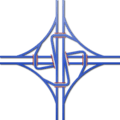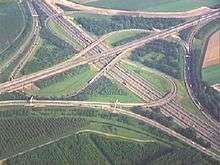Windmill interchange



The windmill interchange is a four-way road interchange.
The windmill serves two arterial roadways by grade separation. All turning movements are served by a right-hand exit ramp, with stop sign or traffic signal at the ramp termini.
Vehicles make right and left-turn movements at the ramp intersections and are removed from the main intersection in conventional intersection design. Left turns can turn into left merge lanes, so vehicles have to wait for gaps in arterial traffic in only one direction (similar to the Continuous Green T-intersection operations.)
This application is best suited for locations where free-flow through movements are desired for both intersecting roadways, with moderate to low turning movement volumes.
This interchange design is best suited for rural locations where ROW is available at the intersection quadrants and quadrant development is low to minimize attraction of turning movement volumes.
A similar concept involves a "Parclo" A4 partial cloverleaf interchange, since that type of junction involves turning traffic off the freeway turning left onto the arterial, though the arterial itself exits with loop ramps eliminating left-hand turns onto the freeway, as well as to not invoke at-grade crossings for left turns onto the freeway.
A variation of the windmill, called the diverging windmill, increases capacity by altering the direction of traffic flow of the interchanging highways, making the connecting ramps much more direct. The interchange is named for its similar overhead appearance to the blades of a windmill.
External links
- 39°02′43″N 82°36′46″W / 39.045219°N 82.612767°W Location of a Windmill near Jackson, OH